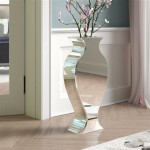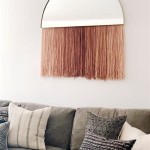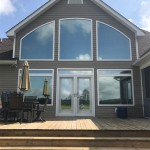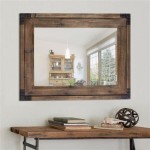How To Build A Lighted Mirror
Lighted mirrors, also often referred to as vanity mirrors with lights or illuminated mirrors, offer enhanced visibility and improved aesthetics, particularly beneficial for tasks such as makeup application, shaving, and other grooming activities. These mirrors provide consistent and directional lighting, minimizing shadows and creating a more accurate reflection. This article provides a detailed guide on how to construct a lighted mirror, outlining the necessary materials, tools, and step-by-step instructions.
Before embarking on this project, it is crucial to prioritize safety. Working with electrical components requires caution and adherence to established safety protocols. It is recommended to consult a qualified electrician if there is any uncertainty regarding electrical wiring. Ensure the working area is well-ventilated and free from obstructions. Disconnect the power supply when working with electrical wiring.
Key Point 1: Gathering Materials and Tools
The first step in building a lighted mirror involves acquiring the necessary materials and tools. The quality of these components will directly impact the longevity and performance of the finished product. Proper selection of materials and tools will ensure the project proceeds smoothly and efficiently.
Mirror Selection: The mirror is obviously the central element. The size and shape of the mirror are matters of personal preference and the available space. Common shapes include rectangular, square, and circular mirrors. Select a high-quality mirror with a smooth, reflective surface for optimal clarity. Tempered glass is preferable for increased safety, particularly in a bathroom setting.
Frame Material: The frame provides structural support and contributes to the overall aesthetic appeal of the lighted mirror. Common frame materials include wood, metal, and acrylic. Wood offers warmth and versatility, while metal provides a sleek and modern look. Acrylic allows for creative design options and can be easily customized. The choice of frame material should align with the desired aesthetic and the surrounding decor.
Lighting Source: The lighting source is crucial for illuminating the mirror. LED strip lights are a popular choice due to their energy efficiency, long lifespan, and even light distribution. Other options include incandescent bulbs, fluorescent tubes, and individual LED bulbs. The selection of the lighting source should be based on the desired brightness, color temperature, and energy consumption.
Electrical Components: The electrical components include the power supply, wiring, switch, and any necessary connectors. A suitable power supply is required to provide the correct voltage and amperage for the chosen lighting source. Electrical wiring should be appropriately sized for the current load. A switch is necessary to control the on/off function of the lights. Connectors will be needed to join the various electrical components together. Confirm local electrical codes and regulations before purchasing and installing electrical components.
Diffuser (Optional): A diffuser can improve the light quality by scattering the light and reducing glare. Diffusers are typically made of translucent plastic or glass. The use of a diffuser can create a softer, more even illumination.
Reflective Backing (Optional): A reflective backing behind the light source can enhance the light output by reflecting light back towards the mirror. Aluminum foil or reflective tape can be used as a reflective backing.
Tools: The required tools include a measuring tape, pencil, saw (for cutting the frame material), drill, screwdriver, wire stripper, wire connectors, soldering iron (optional), safety glasses, and gloves. The specific tools required will depend on the chosen materials and construction methods.
Fasteners: The appropriate fasteners, such as screws, nails, or adhesive, are required to assemble the frame, attach the mirror, and secure the lighting components. The type of fastener will depend on the materials being joined.
Key Point 2: Constructing the Frame and Mounting the Mirror
Once all the materials and tools are gathered, the next step is to construct the frame and mount the mirror. This stage involves precise measurements and careful assembly to ensure structural integrity and a professional finish.
Frame Construction: Measure the dimensions of the mirror and add allowances for the frame edges. Cut the frame material to the required lengths using a saw or other appropriate cutting tool. Ensure the corners are cut accurately to create a clean and seamless joint. Assemble the frame using screws, nails, or adhesive, ensuring the frame is square and stable.
Mirror Mounting: Carefully place the mirror within the frame. Secure the mirror to the frame using mirror clips, adhesive, or a combination of both. Ensure the mirror is securely attached to prevent it from falling out. If using adhesive, choose an adhesive specifically designed for mirrors to prevent damage to the reflective coating.
Routing for Wiring (If Necessary): If the wiring will be concealed within the frame, create channels or grooves to accommodate the wires. This can be done using a router or other suitable tool. Ensure the channels are large enough to accommodate the wires without pinching or straining them.
Applying Finish (Optional): If using a wood frame, consider applying a finish to protect the wood and enhance its appearance. Common finishes include paint, stain, and varnish. Apply the finish evenly and allow it to dry completely before proceeding.
Key Point 3: Integrating the Lighting System
The final step involves integrating the lighting system into the frame and connecting the electrical components. This requires careful attention to detail and adherence to electrical safety guidelines.
Mounting the Lighting Source: Position the lighting source around the perimeter of the mirror or in a location that provides optimal illumination. If using LED strip lights, adhere the strip lights to the frame using the adhesive backing. If using individual bulbs, install the bulbs in their respective sockets or fixtures. Ensure the lighting source is securely attached to the frame.
Wiring the Lighting System: Connect the electrical wiring to the lighting source, switch, and power supply according to the manufacturer's instructions. Use wire strippers to expose the ends of the wires and wire connectors to join the wires together. Ensure the connections are secure and insulated to prevent short circuits. If soldering is used, apply solder sparingly to create a strong and reliable connection. Always use proper grounding techniques.
Installing the Switch: Mount the switch in a convenient location on the frame or nearby wall. Connect the switch to the electrical wiring according to the manufacturer's instructions. Ensure the switch is properly grounded and insulated.
Connecting to Power Supply: Connect the power supply to the electrical wiring according to the manufacturer’s instructions. Ensure the power supply is compatible with the voltage and amperage requirements of the lighting source. Plug the power supply into a properly grounded electrical outlet.
Testing the Lighting System: Before fully assembling the lighted mirror, test the lighting system to ensure it is functioning correctly. Turn on the switch and verify that the lights illuminate properly. Check for any flickering or inconsistencies in the light output. If any problems are detected, troubleshoot the wiring and connections until the issue is resolved.
Securing Wiring and Components: Once the lighting system is tested and functioning correctly, secure all wiring and components within the frame. Use wire ties, staples, or other fasteners to keep the wiring organized and prevent it from interfering with the mirror or other components. Ensure all connections are properly insulated and protected.
Adding Diffuser and Reflective Backing (Optional): If using a diffuser, install it over the lighting source to soften the light and reduce glare. If using a reflective backing, adhere it to the back of the frame behind the lighting source to enhance the light output. Ensure the diffuser and reflective backing are securely attached to the frame.
Final Assembly and Inspection: Once all the components are installed and the wiring is secured, carefully inspect the lighted mirror to ensure it is free from any defects or hazards. Verify that all connections are tight and insulated. Check for any exposed wiring or sharp edges. Ensure the mirror is securely attached to the frame. Clean the mirror and frame to remove any dust or fingerprints.
Mounting the Lighted Mirror: Mount the lighted mirror on the wall or other desired location using appropriate mounting hardware. Ensure the mirror is securely attached to the wall and cannot be easily dislodged. Use a level to ensure the mirror is mounted straight.
By following these detailed instructions, one can successfully construct a lighted mirror that enhances both functionality and aesthetics. Remember to prioritize safety throughout the process and consult with a qualified electrician if needed. The resulting lighted mirror will provide improved visibility and a touch of elegance to any vanity or grooming area.

Diy 20 Light Up Vanity Mirror With Remote

How To Make Cute Lighted Leaning Mirror

Diy Light Up Vanity Mirrors You Can Make Ohmeohmy Blog

Diy Led Framed Mirror Modern Builds Ep 74

10 Diy Vanity Mirror Projects That Show You In A Diffe Light
:max_bytes(150000):strip_icc()/makesandmunchies-c136f898cca640faa72b6209012230cb.jpg?strip=all)
7 Diy Lighted Mirror Ideas To Add A Little Extra Shine Your Space

10 Diy Vanity Mirror Projects That Show You In A Diffe Light

Diy Light Up Vanity Mirrors You Can Make Ohmeohmy Blog

Diy Light Up Vanity Mirrors You Can Make Ohmeohmy Blog

Bathroom Remodel Diy Backlit Mirror Leah And Joe Home Projects Crafts








